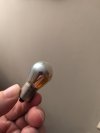As above, overdriven LED's will have a shorter life and age quicker, but the ageing phenomenon isn't as marked as you'd have us think - the first link when searching for 'LED degredation' is this one, which suggests, all things being equal, that it's pretty much a non-issue.
https://lamphq.com/led-degradation/ Of course, the 'buy cheap, buy twice' LED's will have more issues with control electronics, that's not the sort of equipment I work with or buy for myself though - possibly why LED degradation isn't a factor I've ever had to learn about or be troubled with.

suparee.com
